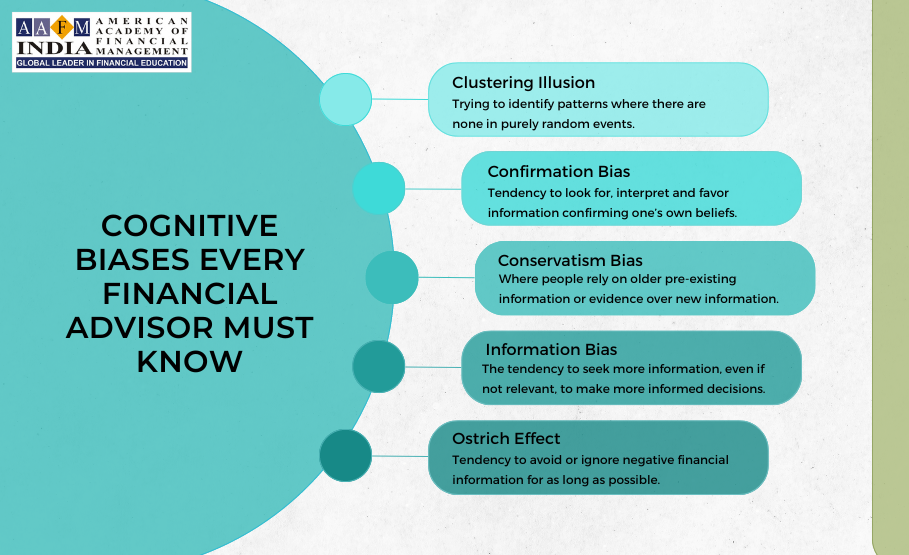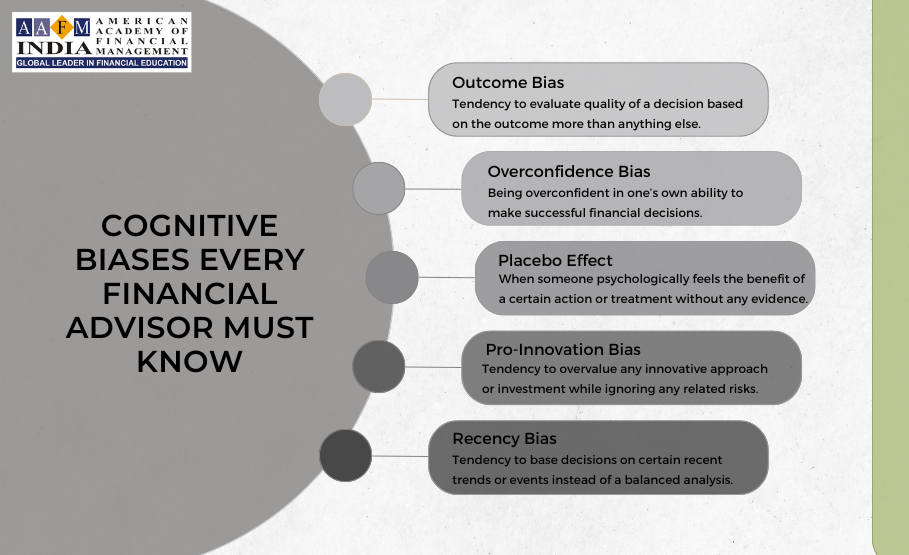20 Cognitive Biases Every Financial Advisor Must Know
 Written by Sonal Sharma - Sat, 15 Mar 2025
Written by Sonal Sharma - Sat, 15 Mar 2025

How These Hidden Biases Are Costing You and Your Clients Big Money?
Cognitive biases can wreak havoc on investment decisions, leading to costly mistakes and missed opportunities. As a financial advisor, understanding these biases isn't just helpful, it's essential. Discover the 20 cognitive biases that could be silently sabotaging your clients' investments and learn how to counteract them for smarter, more effective financial advice.
Cognitive biases are systematic patterns of deviation from norm or rationality in judgment. These biases can significantly impact decision-making processes in investments.

1. Anchoring Bias in Investment Decisions
Definition
Anchoring bias occurs when individuals rely too heavily on the first piece of information they encounter.
Example
In investment decisions, clients might anchor to the initial price of a stock and make subsequent decisions based on this anchor, potentially leading to biased evaluations.
Strategy
Encourage clients to consider the overall market conditions and broader data rather than fixating on initial purchase prices.
2. Availability Heuristic in Financial Planning
Definition
The availability heuristic is the tendency to overestimate the importance of information that is readily available.
Example
Clients might overestimate the risks of investing in the stock market if they frequently hear about market crashes, despite long-term growth trends.
Strategy
Provide balanced information and historical context to help clients make informed decisions.
3. Bandwagon Effect in Stock Market Investments
Definition
The bandwagon effect occurs when the probability of one person adopting a belief increases based on the number of people who hold that belief.
Example
Clients might invest in a popular stock simply because everyone else is doing it, without evaluating its fundamentals.
Strategy
Encourage independent research and critical thinking about investment choices.
4. Blind-Spot Bias in Investment Strategies
Definition
Blind-spot bias is the failure to recognize one’s own cognitive biases.
Example
Clients might criticize others for being overconfident in their investment decisions while failing to see their own overconfidence.
Strategy
Promote self-awareness and regular reflection on investment decisions.
5. Choice-Supportive Bias in Portfolio Management
Definition
Choice-supportive bias is the tendency to remember one’s choices as better than they actually were.
Example
After making an investment, clients might downplay any negative aspects and emphasize the positives, even if there were better options available.
Strategy
Encourage objective assessments and regular reviews of investment performance.

6. Clustering Illusion in Market Analysis
Definition
The clustering illusion is the tendency to see patterns in random events.
Example
Clients might believe that a particular investment will continue to perform well because it has done so in the past, without considering other factors.
Strategy
Provide a broader analysis of market trends and potential risks.
7. Confirmation Bias in Financial Decisions
Definition
Confirmation bias is the tendency to search for, interpret, and remember information that confirms one’s preconceptions.
Example
Clients might only read news articles that confirm their belief in a particular stock, ignoring contrary evidence.
Strategy
Encourage clients to seek out diverse information sources and consider different perspectives.
8. Conservatism Bias in Investment Choices
Definition
Conservatism bias occurs when people favor older evidence over new evidence.
Example
Despite new scientific evidence supporting the benefits of a diversified portfolio, clients might stick to their old, undiversified investment strategies.
Strategy
Present updated research and data to support new investment strategies.
9. Information Bias in Investment Research
Definition
Information bias is the tendency to seek information even when it does not affect action.
Example
Clients might insist on more and more information before making a decision, delaying action unnecessarily.
Strategy
Help clients focus on relevant information and make timely decisions.
10. Ostrich Effect in Market Downturns
Definition
The ostrich effect is the decision to ignore dangerous or negative information by “burying” one’s head in the sand.
Example
An investor might avoid checking their portfolio during market downturns, hoping the problem will go away on its own.
Strategy
Encourage regular portfolio reviews and proactive management.

11. Outcome Bias in Investment Performance
Definition
Outcome bias occurs when the quality of a decision is judged based on the outcome rather than the decision process.
Example
If an investment turns out well by chance, clients might think the decision-making process was good, even if it was flawed.
Strategy
Focus on the decision-making process rather than just outcomes.
12. Overconfidence Bias in Stock Picking
Definition
Overconfidence bias is when someone is excessively confident in their own abilities and knowledge.
Example
Clients might overestimate their ability to pick winning stocks, leading to risky investments.
Strategy
Promote humility and continuous learning in investment decisions.
13. Placebo Effect in Financial Products
Definition
The placebo effect occurs when people experience a benefit after the administration of an inactive "look-alike" substance or treatment.
Example
Investors might feel reassured by an investment decision simply because they believe it’s the right choice, without substantial evidence.
Strategy
Encourage evidence-based decision-making.
14. Pro-Innovation Bias in Tech Investments
Definition
Pro-innovation bias is the tendency to overvalue the usefulness of an innovation and undervalue its limitations.
Example
Clients might get excited about a new tech stock, ignoring potential drawbacks and market risks.
Strategy
Provide a balanced view of innovative investments, highlighting both potential and risks.
15. Recency Bias in Market Trends
Definition
Recency bias is the tendency to weigh recent events more heavily than earlier events.
Example
After a market crash, clients might believe another crash is imminent, despite historical recoveries.
Strategy
Use historical data to provide context and mitigate recency bias.

16. Salience Bias in Investment Selection
Definition
Salience bias is the tendency to focus on the most easily recognizable features of a concept or person.
Example
In advertising, brightly colored packaging might draw more attention and influence buying decisions, even if the product itself is not superior.
Strategy
Encourage clients to look beyond the obvious and consider the fundamentals.
17. Selective Perception in Financial Analysis
Definition
Selective perception is allowing our expectations to influence how we perceive the world.
Example
A sports fan might perceive refereeing decisions as unfair if they go against their favorite team, even if the decisions are impartial.
Strategy
Promote objective analysis and diverse viewpoints.
18. Stereotyping in Investment Decisions
Definition
Stereotyping is expecting a group or person to have certain qualities without having real information about them.
Example
Assuming someone is good at math because they are of a certain ethnicity is a stereotype that does not take individual abilities into account.
Strategy
Encourage looking at individuals and investments on their own merits.
19. Survivorship Bias in Market Success Stories
Definition
Survivorship bias is the error of concentrating on the people or things that “survived” some process and overlooking those that did not.
Example
Looking at successful companies and assuming their strategies are the key to success without considering the numerous companies that used the same strategies but failed.
Strategy
Provide a balanced view by discussing both successes and failures.
20. Zero-Risk Bias in Investment Risk Management
Definition
Zero-risk bias is the preference for reducing a small risk to zero over a greater reduction in a larger risk.
Example
People might favor a medical treatment that eliminates a minor health risk entirely over one that significantly reduces a major health risk, simply because it offers the perception of complete safety.
Strategy
Discuss the trade-offs and encourage balanced risk management.
Conclusion
Understanding these cognitive biases in investment decisions is crucial for making better financial choices in both personal and professional contexts. By being aware of these biases, financial advisors can help clients work towards minimizing their impact, leading to more rational and effective decision-making processes. Whether it's in financial planning, investment strategies, or everyday choices, recognizing and addressing cognitive biases can significantly improve outcomes.
Author by
Comments (0)
Search
Popular categories
Wealth Management
7Finance
7Financial Planning
6Finance Certifications
4Investing
3Wills and Trust
2Latest blogs

Discover the Power of a Private Family Trust in India!
Sat, 15 Mar 2025 0 284

9 Surprising Things You Should Never Include in Your Will (And What to Do Instead)
Sat, 15 Mar 2025 0 203

Why Indian Investors Are Flocking to Factor-Based Passive Funds?
Sat, 15 Mar 2025 0 200
Write a public review